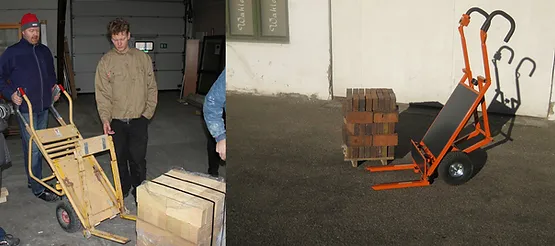Smash hit inventions that solve a simple problem for millions of people might supply the inventor with sufficient royalty-funds for a lifetime. But those smashhits are rare. Jackpot-rare. Instead of hoping for a smashhit we’ve made inventing physical products a growth business by tuning our business model for systematical inventing.
We all know the stereotypical, eccentric renaissance figure who invents machines for time travel and infinite energy. It’s not that we don’t love those characters, but tinkering in a garage is pretty far from our systematical approach as a modern inventing company.
We’ve spend the past few years making Lolle & Nielsen Inventions a profitable company that turns ideas into inventions. Inventions is the heart and soul of the company, but we approach them in a systematical manner in order to get a sturdy business model. A business model that’s a bit unusual but pretty simple at its core:
– Step 1: We find a need in the market or a problem that needs to be solved. – Step 2: We develop a product that satisfies the need or solves the problem. – Step 3: We get the solution to market to make a profit. – Step 4: Repeat step 1, 2 and 3.
In reality it’s a bit more complicated though. Unique inventions are in themselves a complicated matter, and there are different routes to the goals of every step as well – meaning we add partnership and apply different strategies to every invention.
Crowdfunding, licensing or government funds? A development partner or a partnership for prototype testing? Every time it’s all about finding the model that suits the invention.
If you want some examples I’ve added a few cases in the bottom of the post.
Adding business
While the engineering aspects of our inventions are the core, we have to think business early on as well. How big is the market for this solution? How unique is the solution? Is the concept sustainable as a business?
We rarely do the selling ourselves, but license our inventions to larger companies with experience in manufacturing and distribution. Nevertheless we need to apply business brain early on. If the market for our invention is too small, if it’s too complicated to produce in scale, if we haven’t done our patenting homework – then it doesn’t matter how great a product we’ve build, we won’t be able to get a licensing deal in the end.
On way to comply with this issue is by doing partnerships and testing our solution in the real world as early as possible – as mentioned in the earlier post about physical mockups.

We do spend a lot of time in our workshop, but the business brain has to be involved as well as our engineering skills.
It takes time to build
It has taken a few years to figure our business model out and fine tune it, but now we are getting to the point, where we are approaching a steady income from our licensing agreements. In order to optimize the number of successful inventions we make, we’ve learning how to validate ideas fast – and ditch them, if they for some reason don’t work, before we throw too much time an money after it.
But even if we had our fine tuned business model and our current experience when we started, an inventing company doesn’t just happen over night. Inventions are long term investments, as most products takes upwards of two years from idea to market (so most likely 3 years).
Lolle & Nielsen Inventions demanded our patience for the first few years before we got a sturdy economy. We were dependent on external funding as well as consulting gigs to make ends meet. In that phase it was always a tightrope between spending our time on consulting to earn money and spending time building our company. But we’ve thankfully reached a point, where we have more influence on the project we pick, and we’re on our way to become completely independent from consultant gigs.
Constant State of Startup
Since our beginning in 2010 we’ve matured immensely as a business. This however doesn’t mean that the startup-feeling is gone.
For every invention the initial steps we make (need and development) are the same as most startups face in the beginning. The difference from startups is, that we hand over our idea when it has matured and start over, which leaves us in a constant state of entrepreneurship.
As a modern inventing business we are both the startup and the venture fund. Every new invention is a new startup we have to develop and get funded – and evaluate the risk for in order to do what’s best for Lolle & Nielsen Inventions. Which means we constantly get to go what we love: Solve real problems with real inventions.
CASE: OPLØFT – Need: We wanted a more compact and sleek height-adjustable desk for our own office, to improve ergonomics while keeping the office space pretty. – Development: Conceptualizing and prototyping inhouse. Prototype-testing with users inhouse. – Go-to-market: Initially crowdfunding with outsourced production but switched to a “right to commercialize”-partnership with manufacturer and distributor Posturite.

The final prototype of OPLØFT.
CASE: UPCLIMBER – Need: We observed the need for at tool while making other tests on building sites. We conceptualized our idea and sold a part of the project before it was even made. – Development: Conceptualizing and prototyping inhouse. Prototype-testing at building site with partner-contractors. – Go-to-market: Licensing agreement.

CAD drawing of the UPCLIMBER-concept.
CASE: SMARTMOVER – Need: The industry got in touch with us with their need. The need had been there for a long time, but nobody had solved it yet. – Development: Shared effort and ownership with a manufacturer from the beginning. – Go-to-market: Licensing agreement.

A protype and the final version of SmartMover.
